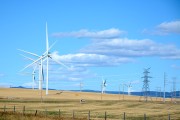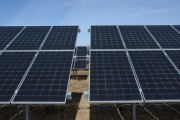In a world desperate to respond to the potentially dangerous effects of global warming, Alberta has come to a major fork in the road: should it continue to rely on the dirty, brown, coal-fired electricity technologies of the past, or should Alberta diversify and develop the clean green electricity technologies of the future?
Alberta currently relies on coal for more than 70 per cent of its power. But both Albertans and Canadians at large have repeatedly indicated in polls that money ought to be invested in renewable energy, particularly money collected from climate change polluters.
Perhaps there is wisdom in the masses of Albertans and Canadians who want global warming dealt with, and prefer renewable energy as a solution.
 Albertans are responsible for almost four times as much global warming pollution as the average Canadian. And close to 25 per cent of Alberta's GHG pollution comes from its electricity sector. Given the urgent need to tackle global warming, it is clear that coal-fired power is becoming a liability.
Albertans are responsible for almost four times as much global warming pollution as the average Canadian. And close to 25 per cent of Alberta's GHG pollution comes from its electricity sector. Given the urgent need to tackle global warming, it is clear that coal-fired power is becoming a liability.
Alberta's renewable energy resource is vast. A new study by the Pembina Institute has found that Alberta could go from producing 70 per cent of its electricity from coal to 70 per cent from clean energy sources in just 20 years.
Using existing renewable energy technologies combined with industrial co-generation and energy efficiency, Alberta could satisfy growing demand for power. It would not need to build a single new coal-fired power plant and could start to phase out the ones already polluting the air.
We find inspiration for this by looking both to the past and to the future.
In 1889, entrepreneur Peter Prince built Alberta's first major power plant. Not only did the plant produce electricity to light Calgary's streets from a renewable fuel - waste sawdust from a local lumberyard - the heat produced by the plant was used in the lumber mill. Compare this to the average coal-fired power plant in Alberta today, which burns a non-renewable fossil fuel and wastes more than 60 per cent of the energy out the smokestack. A return to renewable energy and co-generation of power and heat in industry and buildings holds much promise for Alberta.
In fact there is a multitude of proven technologies Alberta can use to join a worldwide race to tap into new clean energy sources such as wind power. While there is enough wind in Alberta to meet the province's electricity demands many times over, Alberta produces just two per cent of its electricity from wind today.
Renewable energy already employs more than 215,000 people in Germany, and the Germans earned approximately $10 billion in export revenue from wind energy technology alone in 2007. In the last five years Germany has installed more wind power than all the coal, gas and other technologies installed in Alberta.
Germany is not alone. Renewable energy continues to boom worldwide, growing 30 per cent annually for decades.
Europe has for years been on the leading edge of understanding how to integrate large amounts of variable power into their grids. Denmark generates more than 20 per cent of its electricity from wind. On particularly windy days Spain is able to generate 40 per cent of its electricity from the wind. But the wind doesn't always blow, which is why diversity in an electricity system is essential. When the wind stops, a combination of stored energy, virtual power plants, natural gas peaking plants and power imports can make up the difference in real time.
Of course, wind is not the only renewable resource that is bountiful in Alberta. Geothermal, biogas, biomass, low-impact hydro and solar power all have roles to play in a sustainable electricity future for the province.
Alberta has an incredible opportunity to transform its brown electricity supply system to a clean, green, competitive system of the future. An excellent start would be for Premier Stelmach to establish a renewable energy task force and follow that with immediate investments in renewable energy.
Alberta has already invested $2 billion in the uncertain technology of carbon capture and storage to clean up emissions from coal and oil and gas. A similar investment should be made to rapidly scale-up already proven renewable energy industries. This would demonstrate vision. Indeed, this would signal to the world that Alberta is not only trying to clean up its carbon pollution, but that Premier Ed Stelmach and the province are diversifying the economy by transforming the electricity supply system into one of the greenest in the world.
Tim Weis is the Director of Renewable Energy and Efficiency Policy and Jeff Bell is a Policy Analyst for the Alberta Energy Solutions team with the Pembina Institute. Download the full report: Greening the Grid, Powering Alberta's Future With Renewable Energy.





